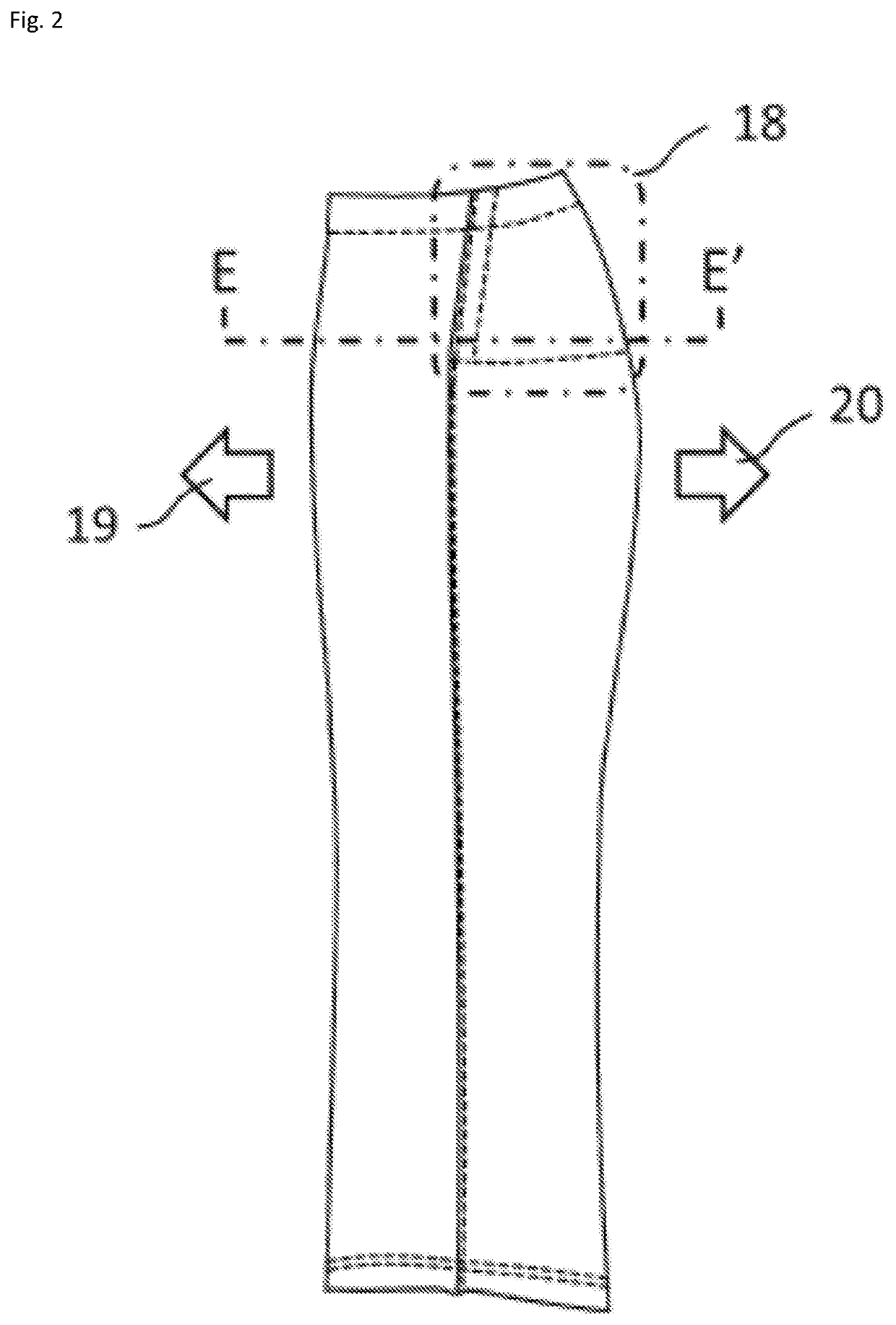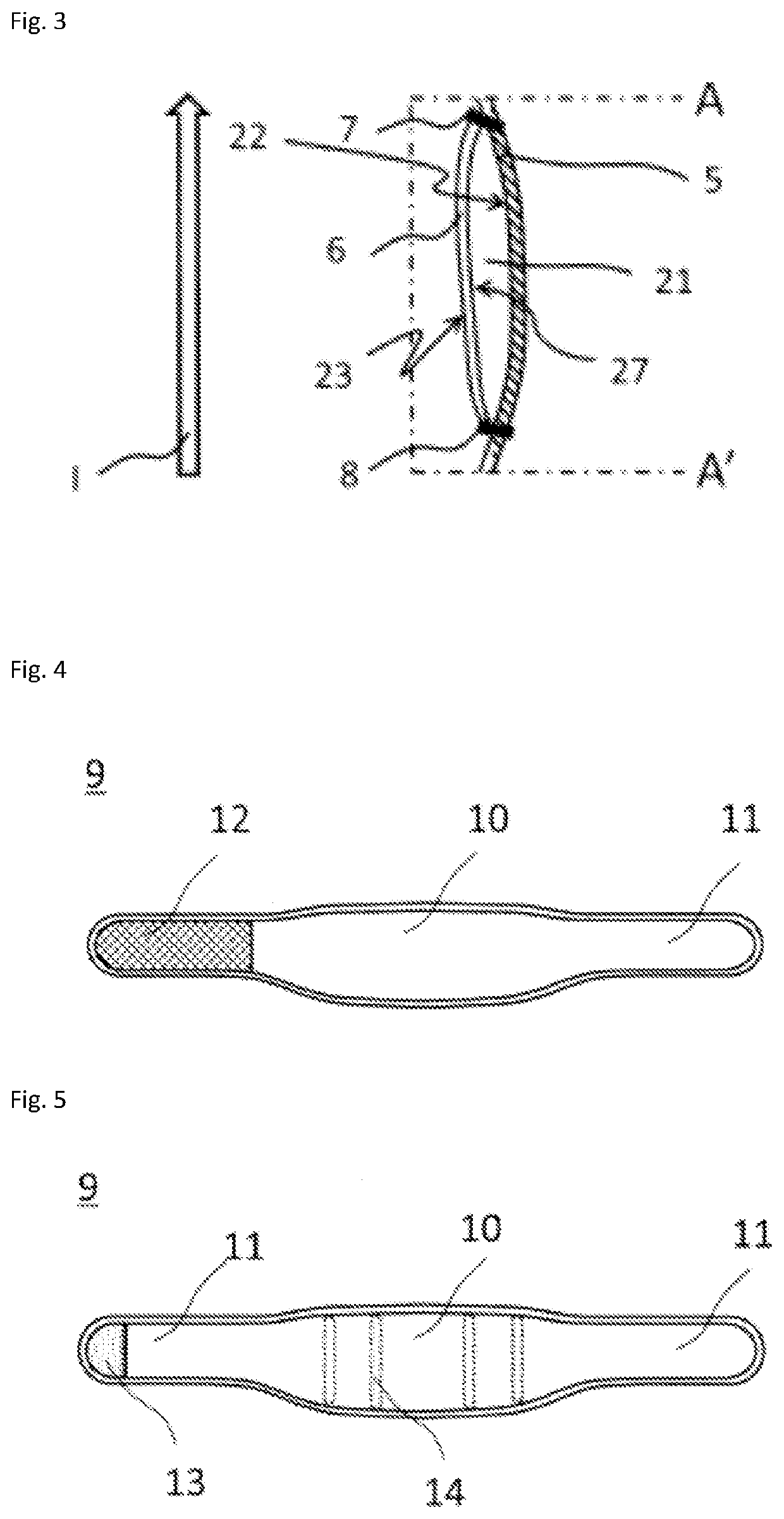Bottom wear
- Summary
- Abstract
- Description
- Claims
- Application Information
AI Technical Summary
Benefits of technology
Problems solved by technology
Method used
Image
Examples
example 1
[0163]Polyethylene terephthalate yarns of 167 dtex and spun yarns with 65% of polyester and 35% (mass ratio) of cotton were used as warp threads, and polyethylene terephthalate yarns of 167 dtex were used as weft threads to weave a warp double twill fabric at a warp density of 154 threads / 2.54 cm and a weft density of 64 threads / 2.54 cm, thereby obtaining a cloth A for cloth of bottom wear with 90% of polyester and 10% of cotton.
[0164]Subsequently, nylon yarns of 78 dtex and polyurethane elastic fiber of 310 dtex were used to knit a fabric, thereby obtaining a power net cloth with 82% of nylon and 18% of polyurethane (hereinafter, the power net cloth is referred to as a “cloth D”).
[0165]The cloth A for cloth of bottom wear bottom was used as a cloth of bottom wear to prepare a bottom wear having an appearance as shown in FIGS. 1 and 2 and an inner part as shown in FIG. 3. That is, the fabric of the cylindrical part rear portion in FIG. 3 is a bottom wear cloth on the back portion in...
example 2
[0166]A cloth of bottom wear was prepared using the same cloth A as used in Example 1, and further, the same cloth D as used in Example 1 was used to prepare a cylindrical part, thereby preparing a bottom wear having an appearance as shown in FIGS. 1 and 2 and an inner part as shown in FIG. 3. That is, the fabric of the cylindrical part rear portion in FIG. 3 is a bottom wear cloth on the back portion in the waist-encircling section of the cloth of bottom wear formed of the cloth A, and the fabric of the cylindrical part front portion (planar material) is the cloth D. In addition, one slit as shown in FIG. 1 was provided at the central part of the cylindrical part front portion, a cylindrical part was prepared in such a manner that the ratio (W2 / W1) of the width of the slit in the longitudinal direction (W2) to the width of the cylindrical part (W1) was 0.94. The protection band for lumbago 1 having a configuration as shown in FIGS. 4 and 5 was attached to the cylindrical part of th...
example 3
[0167]A cloth of bottom wear was prepared using the same cloth A as used in Example 1, and further, the same cloth D as used in Example 1 was used to prepare a cylindrical part, thereby preparing a bottom wear having an appearance as shown in FIGS. 1 and 2 and an inner part as shown in FIG. 3. That is, the fabric of the cylindrical part rear portion in FIG. 3 is a bottom wear cloth on the back portion in the waist-encircling section of the cloth of bottom wear formed of the cloth A, and the fabric of the cylindrical part front portion (planar material) is the cloth D. In addition, one slit as shown in FIG. 1 was provided at the central part of the cylindrical part front portion, a cylindrical part was prepared in such a manner that the ratio (W2 / W1) of the width of the slit in the longitudinal direction (W2) to the width of the cylindrical part (W1) was 0.75. The protection band for lumbago 1 having a configuration as shown in FIGS. 4 and 5 was attached to the cylindrical part of th...
PUM
 Login to View More
Login to View More Abstract
Description
Claims
Application Information
 Login to View More
Login to View More - R&D
- Intellectual Property
- Life Sciences
- Materials
- Tech Scout
- Unparalleled Data Quality
- Higher Quality Content
- 60% Fewer Hallucinations
Browse by: Latest US Patents, China's latest patents, Technical Efficacy Thesaurus, Application Domain, Technology Topic, Popular Technical Reports.
© 2025 PatSnap. All rights reserved.Legal|Privacy policy|Modern Slavery Act Transparency Statement|Sitemap|About US| Contact US: help@patsnap.com



